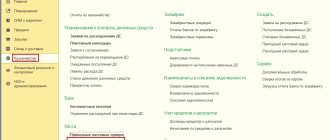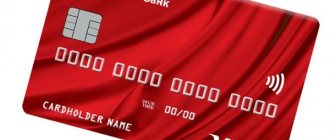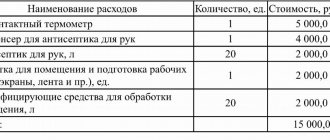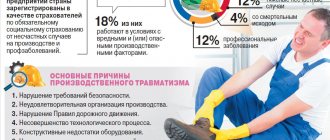How to set a cash limit
Reader's opinion
“We are not happy that the cash limit must be set ourselves, without the bank. The bank has always approved a limit for us that is much higher than what was calculated, but now it won’t work out that way.”
Elena Kutsko,
chief accountant, Krasnodar region
As we mentioned in the previous issue, now the cash balance limit at the cash desk does not need to be agreed upon with the bank. You must install it yourself, and the director must approve it with his order. 1.2 Provisions. However, this cannot be done arbitrarily. The limit must be calculated using a special formula. 1.3 Regulations; appendix to the Regulations. It takes into account the amount of cash received in the past. For what period to take this indicator, you decide for yourself. The only limitation is that the billing period should not be more than 92 working days of your organization (and not those that are not weekends and holidays in accordance with the Labor Code, Articles 111, 112 of the Labor Code of the Russian Federation). In addition, when setting a limit, be guided by your plans for collection of proceeds.
So, if you have cash income, you need to calculate the limit. I appendix to the Regulations:
Please note: you set the last indicator in the formula yourself. That is, before calculating the limit, you need to decide how often you want to deposit cash proceeds to the bank. Or study your collection agreement with the bank.
For a newly created organization, the limit can be calculated based on the expected volume of revenue during the billing period.
If you do not have cash proceeds, you need to calculate the limit based on the volume of cash issued (with the exception of money intended for the payment of salaries and other payments to employees). II appendix to the Regulations:
For a newly created organization, if it does not plan to receive cash proceeds, the limit can be calculated based on the expected volume of cash disbursement.
The billing period does not have to include business days immediately preceding the year in which you set the limit. That is, you can take any period convenient for you. For example, if you want the limit to be the maximum possible, take 1 day for the billing period, on which you had the peak of receipt of revenue or payments from the cash register (if you do not have cash revenue).
If you have separate divisions without a current account, then in calculating the limit of the parent organization you need to include cash stored in such divisions. And for each division that has its own current account, you need to set a separate limit based on the indicators of this Japanese division. 1.2 Provisions.
May be fined
for the following
violations of cash discipline ych. 1 tbsp. 15.1 Code of Administrative Offenses of the Russian Federation:
- cash settlements with organizations or entrepreneurs in the amount of more than 100,000 rubles. one contract at a time;
- non-receipt or incomplete receipt of cash to the cash desk;
- non-compliance with the procedure for storing free money;
- accumulation of cash in excess of the limit.
For organizations, the fine is from 40,000 to 50,000 rubles, for officials and entrepreneurs. Note to Art. 2.4 Code of Administrative Offenses of the Russian Federation - from 4000 to 5000 rubles.
Previously, the limit was set for the entire upcoming year, Appendix 1 to the Regulations of the Central Bank of the Russian Federation dated 01/05/98 No. 14-P (although the bank could revise it at the request of the client, app. 5 of the Procedure). Now the period for which the limit should be set is not defined. It is better, when approving a limit, not to indicate at all until what day it is valid, but to specify only the date from which it is valid. Then, if necessary, you can change the limit at any time. So, if cash revenue (or cash expenditure) has increased and the cash balance no longer “fits” into the limit you previously set, then nothing prevents you from setting a new limit for the future based on increased receipts.
There is no need to bring the limit order to the bank either for approval or review.
What if an error was made in calculating the limit, which led to its overestimation? Then, for accumulating cash in the cash register in excess of the correctly calculated limit, the tax authorities may fine you. 1 tbsp. 15.1, part 1 art. 23.5, part 1 art. 28.3 Code of Administrative Offenses of the Russian Federation.
Cash desk under the simplified tax system “Income”: operating principle, reporting
The new generation cash register is a tool created to ensure control by the Federal Tax Service in the field of circulation of goods and services. The introduction of online cash registers is intended to replace outdated algorithms for maintaining documentation and reporting.
Algorithm for the operation of the cash desk under the simplified tax system “Income”:
- The cashier or courier enters data about the upcoming purchase into the cash register.
- The cash register generates a check with details
- The data goes into the fiscal drive, which signs the check for the cash register, and also sends transaction data to the fiscal data operator (hereinafter referred to as FDO).
- The OFD processes transaction data.
- The OFD sends a check with information about the income received to the tax service.
- The client receives a printed paper receipt or an electronic version of the document.
When will you have to deposit your cash proceeds to the bank?
As before, organizations are required to store cash in excess of the cash balance limit (they are classified as free money in the Regulations) in the Epoch bank. 1.4 Provisions.
That is, as soon as the limit is exceeded, the excess money will need to be handed over to the bank. But there are exceptions.
Now not only storage, but also accumulation of cash in excess of the limit in the cash register is permissible:
- on the days of payment of salaries, scholarships and other social payments, etc. 1.4 Provisions. Previously, it was impossible to accumulate cash proceeds in the cash register for these purposes - money for this had to be received from the bishop's bank. 7 Order;
- on weekends and holidays, if there are cash transactions on these days. 1.4 Provisions.
Money received from the bank for the payment of salaries, scholarships and other social benefits can be kept in the cash register for not 3, but 5 working days (including the day of their receipt). 4.6 Provisions.
Why donate your proceeds?
Not everyone understands why an individual entrepreneur needs to hand over proceeds to the bank. This procedure is enshrined in the Directive of the Central Bank dated March 11, 2014 No. 3210-U and is associated with ensuring financial security. Establishing cash limits for organizations also allows the state to control the movement of money within the country.
Entrepreneurs who have not opened a current account and do not use cash registers (often working with the simplified tax system for a single tax) may not adhere to the limiting rules. Other business entities are required to set limits. Otherwise, entrepreneurs face administrative or criminal liability.
However, there are exceptions when the cash limit can be exceeded without being held liable:
- if it is a holiday or day off, but the enterprise is open;
- during statutory payments (salary, stipend).
On video: Cash transactions. Legislative changes
What can you spend cash from the cash register on?
Previously, cash received from the bank could only be spent on the purposes specified in the check. 4 Orders. Now there are no restrictions on spending such money. Just remember the limit for cash payments under agreements between organizations (entrepreneurs) - 100,000 rubles. one transaction per 1 Directive of the Central Bank of the Russian Federation dated June 20, 2007 No. 1843-U.
WE WARN THE MANAGER
If you do not take measures that will ensure the safety of money when stored at the cash desk and during transportation, then
the cashier will not be financially responsible for them. After all, such liability occurs in the presence of the employee’s guilt and unlawful behavior. 233 Labor Code of the Russian Federation; clause 4 of the Resolution of the Plenum of the Supreme Court of the Russian Federation dated November 16, 2006 No. 52. It is not the cashier’s fault that the employer did not take care of the safety of the money.
But cash proceeds still cannot be spent on everything. Although the Regulations say nothing about the possible purposes of its expenditure, a closed list of them is enshrined in another document of the Central Bank of the Russian Federation. Cash proceeds can only go to:
- for the payment of salaries, scholarships and other payments to employees;
- purchase of goods (except for securities), works, services;
- travel expenses;
- refund to customers of money for goods previously paid in cash and returned to you by them, work not performed by you, services not provided by you.
That is, you cannot, for example, repay or issue a loan from cash proceeds.
Exceptions to the rule
So, I argue that an individual entrepreneur can take money from the cash register as much as he needs and for any purpose, having correctly completed this cash transaction. And that the expenses that he then makes from this money no longer have anything to do with cash transactions. However, it is necessary to mention several situations that can be classified as “exceptions”.
Firstly, an individual entrepreneur cannot pay salaries to employees out of his own pocket. This can only be done from the cash register. If there is not enough money in the cash register, you need to withdraw it from the bank. Or an individual entrepreneur can deposit his personal money into the cash register. Both are formalized by a receipt order. And only then, according to the statement, the cashier or the entrepreneur himself must issue the salary to the employee.
The second exception is the issuance of money to an employee on account. This also needs to be done only from the cash register. Of course, in life it may well look like an individual entrepreneur took money out of his wallet and ordered “buy such and such.” But according to the documents, this must be processed through the cash register - first a receipt from the entrepreneur, then a cash order for the issuance of money on account and, of course, a corresponding application with the resolution of the individual entrepreneur.
What to pay attention to when preparing cash documentation
The Regulations say that on receipts for the PKO, in the payroll sheet, you need to put a stamp containing “details confirming the cash transaction” paragraphs. 2.3, 3.2 Provisions. Accountants who have managed to familiarize themselves with the Regulations are perplexed: what are these details? It's simple: we mean the traditional stamps “Paid”, “Accepted”, “Issued” with the current date. The cashier must be provided with such stamps. 2.3 Provisions.
In addition, the cashier must have a card with sample signatures of everyone who has the right to draw up cash documents. 2.1, 2.2, 2.3 Provisions. This can be a manager, chief accountant, accountant or another employee authorized by the manager (to whom the director has issued a power of attorney), etc. 2.2 Provisions. When issuing and accepting money, the cashier is required to check the signature on the cash order with the sample of the cash register he has. 3.2, 4.2 Provisions. Actually, this procedure was implied before - the cashier was obliged to verify the authenticity of the signature on the cash document. “a” clause 20 of the Procedure, only a card with signature samples was not required.
The book of accounting of funds accepted and issued by the cashier in form No. KO-5 (transactions between the senior cashier and cashiers are entered into it) The Regulations allow keeping them in electronic form, without printing out a paper copy. But only on the condition that the senior cashier and cashiers sign it using an electronic signature, and the manager and the chief accountant (accountant) certify the number of sheets in the electronic signature with an electronic signature. 2.5 Provisions.
Individual entrepreneur cash book - how to fill it out
Competently filling out an individual entrepreneur's cash book does not depend on the fact of using a cash register or the use of special modes. The rules for entering data are the same for all business entities; standard forms are approved by the State Statistics Committee in Resolution No. 88 of August 18, 1998. What documents are required to be kept for the general accounting of cash?
Cash document flow includes the preparation of the following forms:
- Cash book KO-4.
- Receipt orders KO-1.
- Expense orders KO-2.
- Sheets – settlement and payment f. T-49, settlement T-51, payment T-53. They are used optionally for payroll settlements with personnel.
The listed documents form the backbone of accounting for cash transactions, and the cash book is a consolidated journal that displays the movement of cash inflows and outflows. The document is opened for the calendar year and maintained in chronological order. Format – electronic or paper. The first is printed at the end of the period, the second is issued for each cash day. The individual entrepreneur’s cashier is appointed as the responsible employee for filling out KO-4; certification of the document is entrusted to the entrepreneur. Let's talk about the rules for filling out the journal.
The procedure for creating an individual entrepreneur's cash book:
- Title page – details of the entrepreneur are given: full name, codes, reporting period.
- Internal sheets - one page is allocated for each cash day, where they indicate data on incoming transactions (by entering PKO numbers/dates) and outgoing transactions (by displaying data on cash register numbers/dates). At the end of the day, the totals for income and expenses are compiled, and the balance in the cash register is calculated. The cashier checks documentary data and actual cash.
- The last sheet is where the book is certified: the magazine is stitched, the pages are pre-numbered, and the number of pages and a signature with the date are indicated on the outside of the document. This norm, according to Instructions No. 3210-U, is no longer mandatory; the lack of firmware and certification is not considered a violation.
The cash book must be filled out without errors, corrections or omissions. If an inaccuracy has been made, the correction is made according to the correction rules - by crossing out the incorrect entry, entering the correct one, and certifying it with the signature of the individual entrepreneur. If no transactions were carried out at the entrepreneur’s cash desk during the day, make entries in f. KO-4 is not required.
Sample of a standard cash book form f. KO-4 is possible.
Reporting - upon request
Cash on account can now be issued to employees only upon their applications, which contain the manager’s handwritten inscription about the amount of cash and the period for which it must be issued, as well as his signature and date of application. 4.4 Provisions. Until now, let us remind you, the signature of the manager and the chief accountant at the RKOp was enough. 14 Order. The director can, by his order (power of attorney), transfer the authority to sign such statements to one of his subordinates, because in the Regulations, a manager also means persons authorized by him. 1.2 Provisions.
The individual entrepreneur takes the money from the cash register
First of all, let's divide the situation into two parts.
An entrepreneur may have employees who need to be given money on account. In this case, the rules are exactly the same as for organizations. Only the individual entrepreneur himself acts as a leader. In the same way, the employee writes a statement, the entrepreneur puts down a resolution, the cashier (or the individual entrepreneur himself) issues money from the cash register, and draws up a cash receipt order. Then this employee spends the money and prepares an expense report.
The situation is completely different if the individual entrepreneur himself takes the money from the cash register. For example, to purchase goods or pay for services or rent. How to be in this case? Also register money for reporting?
But here a counter question arises: who should I report to? All the money that an individual entrepreneur “spins” in entrepreneurial activity belongs to him from the moment it reaches the cash desk or bank account until the moment it leaves this account or cash desk.
It turns out that if an individual entrepreneur takes money on account, then he must report to himself. But this is absurd! Therefore, I believe that an individual entrepreneur should not write a statement to himself and take money on account. He simply takes money from the cash register for his needs: either for business purposes or for personal needs. In this case, an expense cash order must be issued. But no statement. A verbal instruction to the cashier, if there is one, is sufficient.
The rationale for this conclusion is clause 4.4 of Regulation No. 373-P. This rule states: “For the issuance of cash for expenses associated with the activities of a legal entity or individual entrepreneur, an accountable employee (hereinafter referred to as the accountable person) is issued a cash order in accordance with the written application of the accountable person.”
So, we see: - firstly, that only the employee is given money for reporting; - secondly, only the accountable person writes a written statement for this.
The same paragraph 4.4 of Regulation No. 373-P states: “The accountable person is obliged, within a period not exceeding three working days after the expiration date for which cash was issued on account, or from the date of return to work, to present to the chief accountant or accountant, and in their absence, an advance report with attached supporting documents is sent to the manager.”
As we can see, the expense report must also be prepared only by the accountable person. This is logical. An individual entrepreneur does not have to give an account to himself. At least, he is not obliged to do this in writing.
So let's repeat it again. An individual entrepreneur has the right to take any amount from his cash register for any purpose. To do this, he only needs a cash receipt order. No application or subsequent advance report is required.
I feel that a wave of perplexed questions will fall on me here. The main one is: “How will an individual entrepreneur take into account his expenses?” How can we do without an advance report? It doesn't work out, does it?
We suggest you read: How to sue Tinkoff Bank for a loan
How to maintain a cash book if there are separate divisions
The previous Procedure provided that an organization could have only one cash book. 23 Order. Now, separate divisions that have a current account process their own cash transactions and maintain their own cash book. 5.6 Provisions because:
- They have their own cash register and their own cash balance limit. 1.2 Regulations;
- They can hand over their cash to the bank checkpoint themselves. 1.5 Provisions.
A sheet of this book after withdrawing the cash balance at the end of the day must be transferred to the parent organization no later than the next business day. If the book is on paper, then you need to submit a tear-off sheet, and if in electronic form, then a printed second copy. You can also send the sheet electronically, then you will still have to give a printout with signatures, but not necessarily on the same day - the transfer procedure must be approved by the director of the RP. 5.6 Provisions.
The need to maintain a document
A cash book is a special document issued in the form of a journal. It records all information about cash transactions. This type of documentation is of a reporting nature and belongs to the accounting category of documents. Under the simplified taxation system, a business entity registered as an individual entrepreneur can only use a non-cash payment system. It does not imply that the individual entrepreneur has a cash book. However, if the entrepreneur’s activities are accompanied by settlement transactions using cash, then he must have a cash register. Therefore, a businessman must keep a journal that clearly displays income and expenditure amounts.
Typically, such transactions using cash payments have to be done when paying for labor. This event can be avoided by concluding a special agreement with a banking institution. It specifies the conditions for issuing bank cards through which non-cash transactions for transferring wages to personnel are carried out.
Entrepreneurs are now required to observe cash discipline
As we have already said, all the rules of the Regulation apply not only to organizations, but also to entrepreneurs. The Central Bank of the Russian Federation did not make an exception for them, despite the fact that their personal and business money is not separated in any way. 24 Civil Code of the Russian Federation.
It is clear that the Regulations apply to the money of individual entrepreneurs only as long as they are engaged in entrepreneurial activities. Otherwise, it would be contrary to the Constitution, according to which every person has the right to independently dispose of his property. 35 of the Constitution of the Russian Federation. It is not clear how to record the transition of cash from one quality to another. The question that arises for the individual entrepreneur in this regard is: how can I now withdraw money from the cash register for personal needs and is it necessary to keep all the money in the bank?
How can an entrepreneur withdraw proceeds for personal expenses?
OPTION 1.
At the end of the day,
take the proceeds from the cash register, writing out the settlement account
and indicating in it, for example: “For personal needs.” This will not be a violation of the rules of cash discipline - neither those that limit the purposes of spending cash proceeds and Directive of the Central Bank of the Russian Federation dated June 20, 2007 No. 1843-U, nor those that oblige you to store excess cash in the bank. After all, at the moment of such withdrawal, the money ceases to participate in business activities (and you recorded this by drawing up the RKO), which means that the norms of the Regulations and Directive No. 1843-U no longer apply to them.
With this approach, setting a limit on the cash balance in the cash register loses all meaning. And if you have previously worked without a current account, then there is no need to open one.
It is still unknown how tax authorities will react to this option. It cannot be ruled out that they will see it as a violation of the rules for storing free money (since it is not handed over to the bank, but is withdrawn into the pocket of the individual entrepreneur) and will try to fine you for this. 1 tbsp. 15.1 Code of Administrative Offenses of the Russian Federation.
OPTION 2.
Therefore, the most cautious ones suggest acting differently:
handing over all excess cash to the bank
for crediting to their “entrepreneurial” current account and
then withdrawing money from it
with the wording “for personal needs.” Thus, the transfer of cash from the business sphere to the personal sphere will be recorded by the bank.
This option is bad primarily because it forces you to pay bank commissions. By the way, they may turn out to be significantly larger than the fine for entrepreneurs (it is a maximum of 5,000 rubles).
How to register expenses as an individual entrepreneur
Let's figure out what works and what doesn't.
First line - purchase of goods - so many rubles - such and such documents Second line - payment of rent - so many rubles - such and such documents
And no advance reports.
The money that the individual entrepreneur takes from the cash register is processed in exactly the same way. I took it, spent it, filed the documents in a folder, made an entry in the Income and Expense Book.
As a matter of fact, the money he took from the cash register may well be “for personal needs.” And only then he can spend this personal money either on a fur coat for his wife or on buying food for a family dinner.
So, let's see what we get.
The operation “Individual entrepreneur took money from the cash register” is an independent cash transaction. It doesn't require continuation. The main thing is to draw up the RKO and make an entry in the cash book as to how much he took.
The operation “Individual entrepreneur bought goods” is another operation, also independent, but has nothing to do with cash transactions. I bought it, took the supporting document, put it in a folder, and recorded the expenses in the Income and Expense Accounting Book.
After all, the main thing for an individual entrepreneur is to correctly account for income and expenses. For this purpose, there is a Book of Income and Expenses.
But the cash book has a completely different purpose - to take into account the cash flows that pass through the entrepreneur in connection with his business activities. The cash book and all cash accounting have no other purpose. If you received cash at the cash desk, reflect the receipt. If you took it from the cash register, reflect the expense.
What income should be reflected in the cash register? Any! And any expense. I withdrew the proceeds from the cash register in my store - record the receipt in the cash register, then took this proceeds to the bank - record the expense in the cash register. If you took money from your current account using a check, record the receipt in the cash register; you paid wages to employees in your store, record the expense in the cash register. If you don’t want to hand over the proceeds to the bank (or maybe you don’t even have an account), if you take all the proceeds for personal needs, record the expense in the cash register.
But “cash expenses” should in no case be confused with expenses for business activities. For example, he took 100 thousand rubles from the cash register “for his pocket”, which can be spent both on personal needs and on business ones. This is a cash expense and must be reflected in the cash book. But there is nothing to reflect in the Income and Expense Book yet - the entrepreneur in this situation does not yet have any expenses.
A day later, with this money I bought 10 thousand rubles worth of office supplies or a service for keeping records from an individual entrepreneur. This is already an expense for business activities - we reflect 10 thousand rubles in the Book of Income and Expenses. A week later I purchased goods for resale for another 20 thousand rubles. This is also a “business” expense - we reflect it in the Income and Expense Accounting Book.
Then I used the remaining 70 thousand rubles to buy furniture for the apartment. Or a fur coat for my wife’s birthday. These are no longer business expenses, but simply personal expenses. We don't write them down anywhere. The money belongs to the individual entrepreneur; he spends it however he wants. From the point of view of the state, there are no problems here either - as long as the individual entrepreneur pays taxes on time and in full.
Let's make it more difficult. This is all clear and beautiful if there are not many entries in the Income and Expense Book. But what if the turnover is large, and you constantly have to buy and buy something? At different times, in different places and for each product, you need to write a line in the Book of Income and Expenses.
If there are a lot of expenses, you can first take into account these expenses separately in a separate table, which I call a register. You can call it a savings sheet or something else.
Let's call it a register of an entrepreneur's expenses for such and such a period. This is a regular table, you can make it in Excel.
Date, contents of expense, supporting document, amount
They collected, for example, per day, or per week, or per month, and the final figure was transferred to the Income and Expense Accounting Book. After all, the other side of the expense report is the same thing.
The main thing is that there are no words “advance report”. As a last resort, these words can be crossed out and written “expense register”. But this is, rather, out of despair, when the program does not allow you to create any other document other than the “advance report”. But I’ll say more about this later.
We suggest you read: Eviction of relatives from an apartment
Let's return to the cash transactions of the entrepreneur. It would seem that everything was simple and logical and there was no point in starting such a detailed conversation. But the fact of the matter is that in practice there are other difficulties. The reason for this is the established habits of accountants and the most popular accounting program in Russia, 1C.
Filling out the table in form KO-4
Filling out the table in question must always be done by entering the correct numbers in the “Balance at the beginning of the day” column, reflecting the amount of cash in the cash register at the time the employee or the individual entrepreneur himself started his work shift.
The balance amount is written in rubles with kopecks separated by commas - for example, “200.75”.
The first column of the table is “Document number”. In the lines below it you need to enter the numbers of the PKO and RKO.
The next column is “From whom received or issued to.” In this area of the table, data is recorded about the company employee who received funds in accordance with the order of the individual entrepreneur (or vice versa - deposited them into the employer’s cash desk). For example, “Andreev A.V.” (if issued by RKO) or “from Antonov E.N.” (if PKO is issued).
In general, individual entrepreneurs do not fill out the column called “Corresponding account number, subaccount” because they do not maintain accounting records and do not use synthetic accounts.
In the “Income” and “Expense” columns, it is necessary to record the amounts of funds for PKO and RKO, respectively - also in rubles with kopecks, separated by commas.









